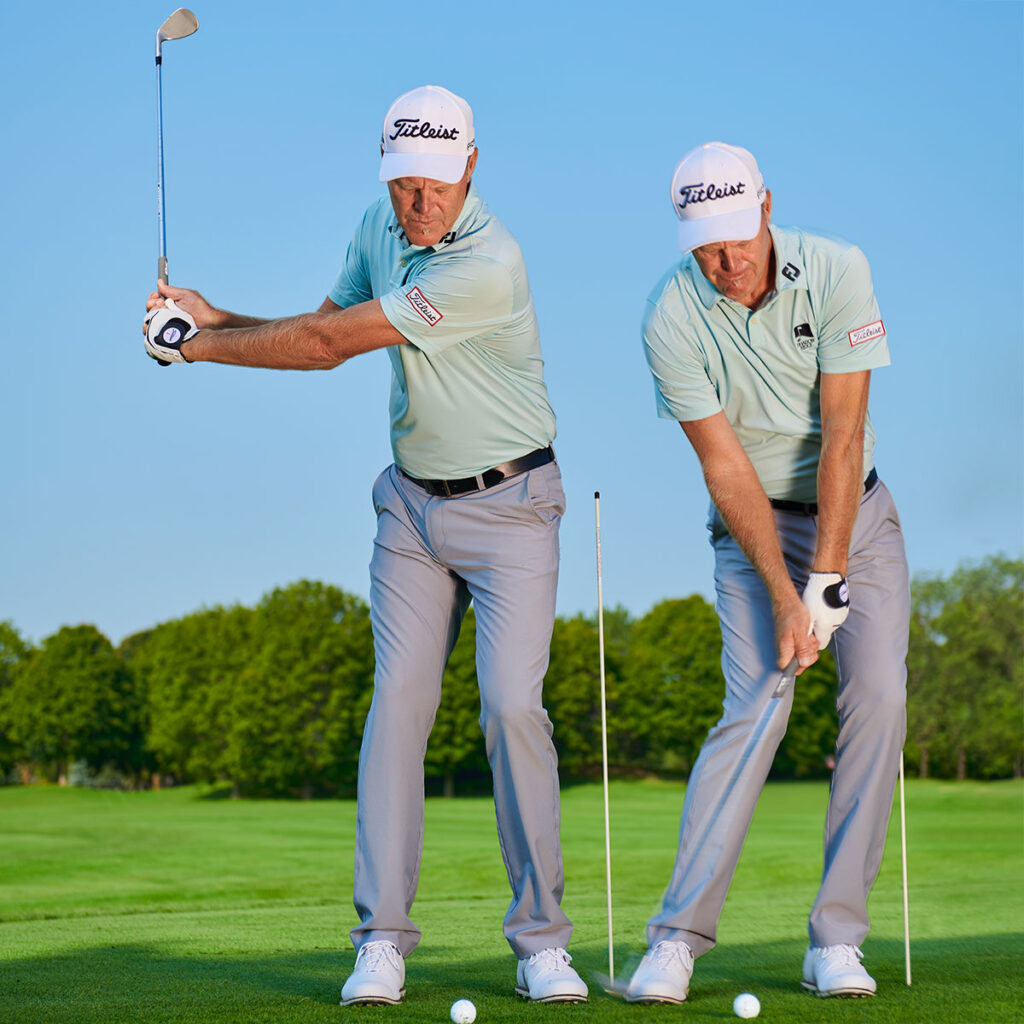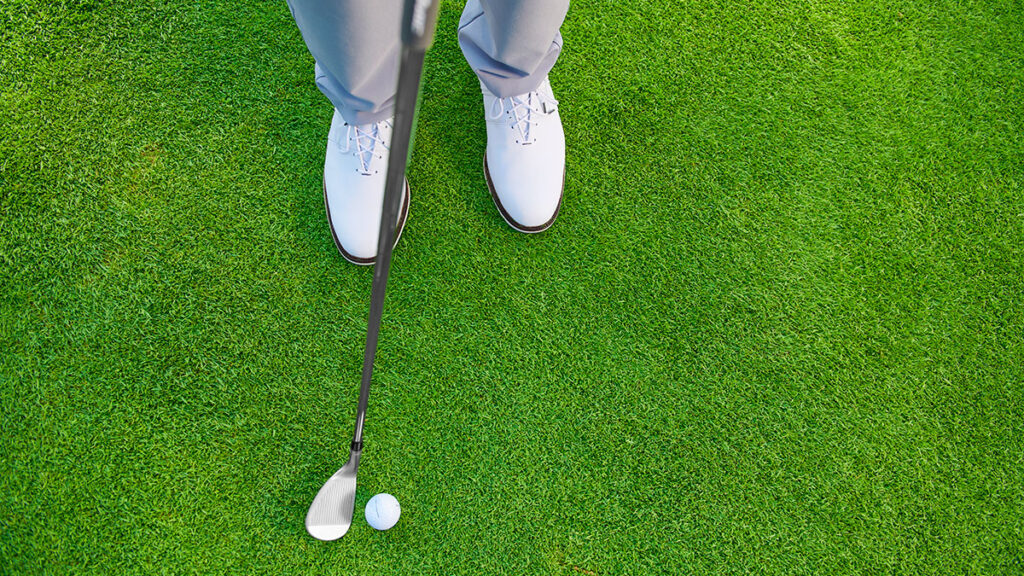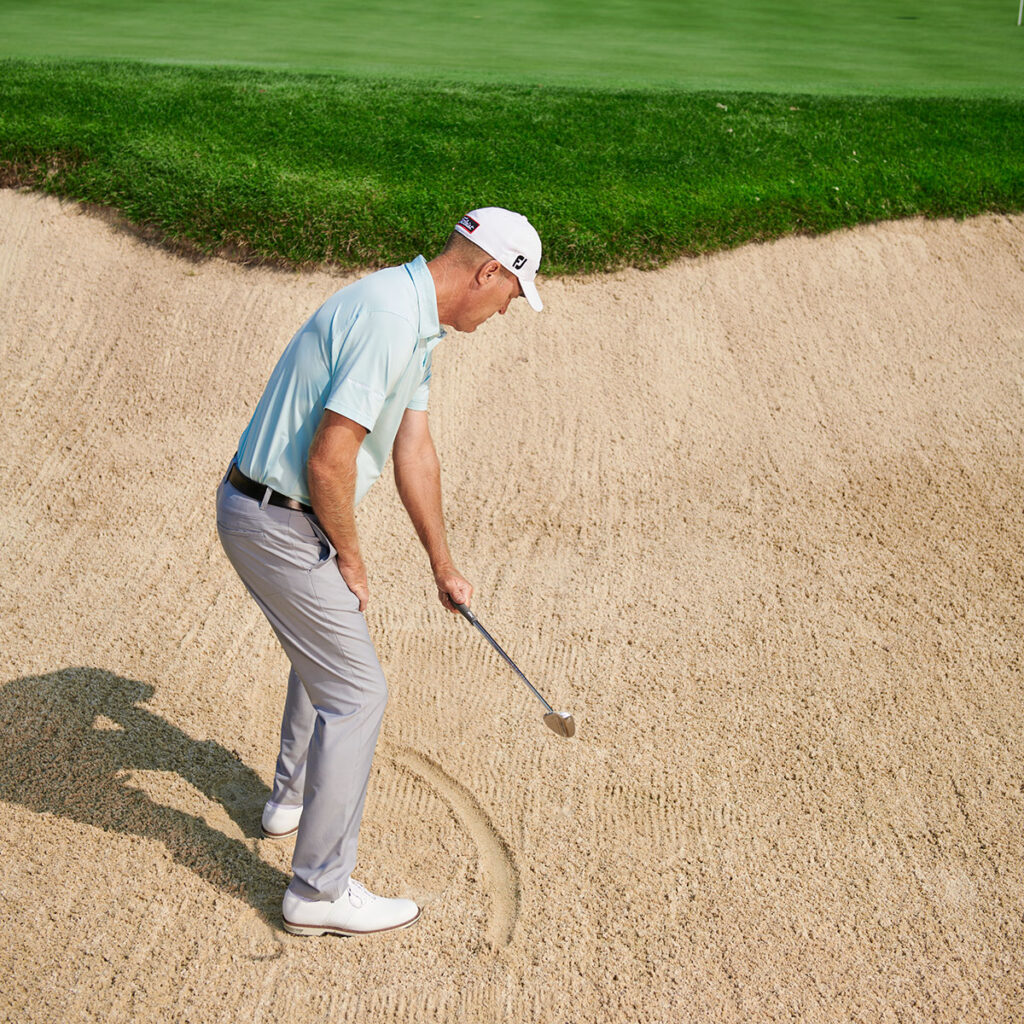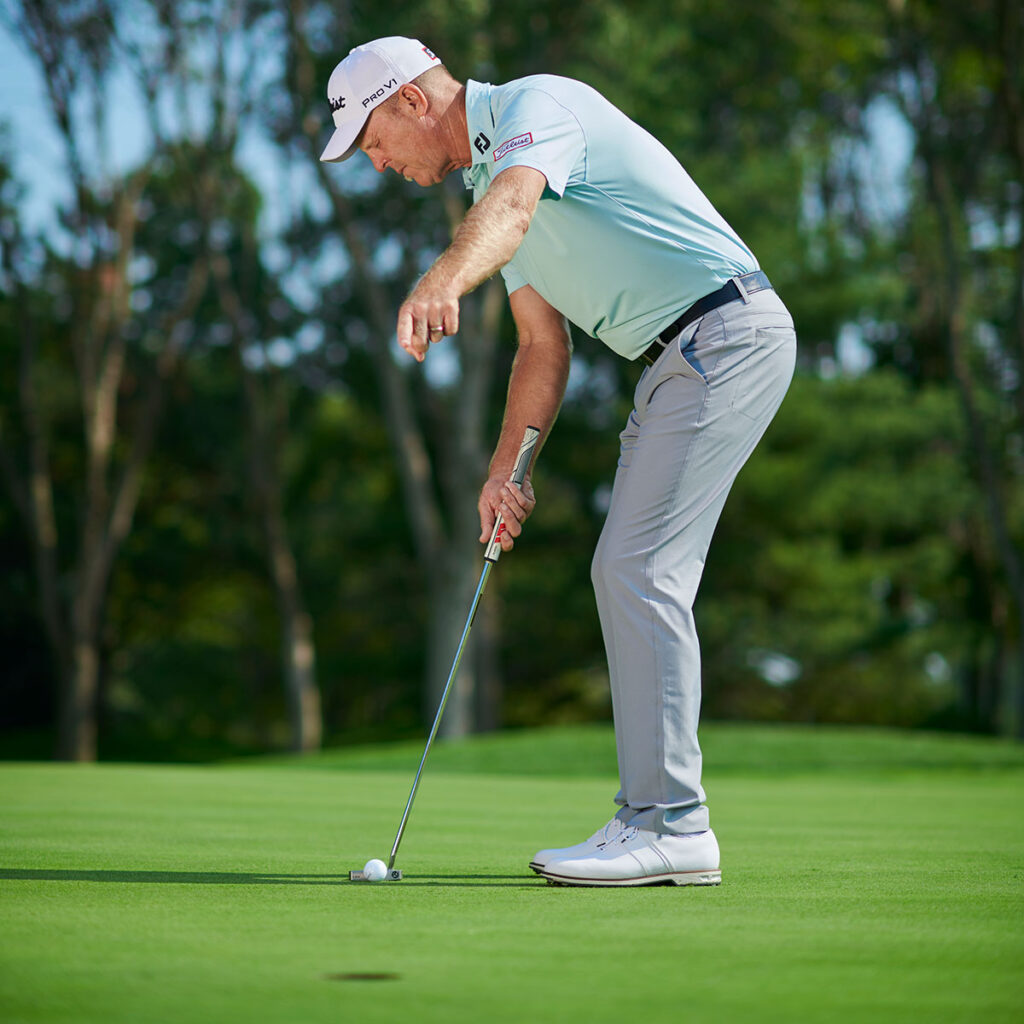Get better around the greens with some tips you’ve probably never heard before.
Photographs by Dom Furore
As a teacher who has worked with amateurs and tour pros for 30 years, I can tell you that short-game fundamentals have evolved quite a bit over time. This is especially true as technology has advanced in ways that make it easy to study and analyse what good players do. I used to have to video the best players and try to spot the commonalities that led to their successes. Now I have the technology to confirm what was previously, to some degree, guesswork.
What has become apparent is that the techniques, movement patterns and strategies high performers use around the greens are not at all what they’re doing in their long game. In fact, it’s almost the complete opposite! If you think finesse wedge shots are a mini-full swing or that putting comes down to focusing on the length of your stroke, you’re probably not scoring your best – maybe not even close.
The first step towards developing a great short game is to change your thinking. Here I’m going to help you throw out the old fundamentals that have proven to be less effective and give you some new ones that will make you dangerous when you grab a wedge or a putter. I’ll get you moving in the right direction.

Distance Wedges
Old fundamental: Slow down your arm swing
New fundamental: Shorten your backswing and rotate through
When I speak of distance wedges, I mean a less-than-full shot into a green that flies lower and is designed to one hop and stop close to the pin. Highly skilled players rarely hit their wedges full – and neither should you. When you go all out, you make contact less predictable, the ball flies too high and accuracy becomes more of a challenge.
The key to executing a distance wedge is to make a slower, shorter backswing and use good full-swing body dynamics to deliver the club into the ball. You want a short enough backswing so that you are inclined to get your body shifting and turning into your lead side as you approach the ball. When I’m working with tour pros, the average amount of forward shaft lean at impact is 13 degrees. They produce this with the proper movement of the pelvis and sequencing rather than trying to lean the shaft forward with their hands. Here are two drills to help you copy what the pros do.

DOWNSWING: Give the ball a punch with your pelvis
Forward shaft lean at impact is key to getting the right contact and trajectory on your distance-wedge shots. You produce it by first shifting laterally into your lead leg as you start down. You then use the ground to rotate your body towards the target as the club moves through the bottom of the swing. The common mistakes are too big a backswing and decelerating in the downswing with minimal lower-body movement. To help you get a feel for the correct action, set an alignment rod in front of your lead hip (or imagine one) at address. The goal is to bump that rod as you swing down [above] and then rotate towards the target with your body. That’s what I call a “pelvic punch”, and it’s the engine of your distance-wedge game.
BACKSWING: Regulate the move
As I mentioned, your backswing should be short enough that it prompts you to rotate your body towards the target in the downswing. How short? I’ll give you two backswing lengths to practise so that you’ll have two distances you carry the ball with each wedge.
Set up square to a ball positioned evenly between your feet in a slightly narrow stance. Take the club back slowly and pivot away from the target with your weight remaining fairly even from one side to the other. Rotate back until your lead arm is parallel with the ground and the butt end of the club is pointing directly down behind the ball on its target line [photo, previous image]. That shortened backswing will encourage you to use your body to deliver the strike. The second backswing is even shorter. The butt end of the club should be pointing at the ball upon its completion.

FINESSE WEDGES
FINESSE WEDGES
OLD FUNDAMENTAL: Lean left and keep your hands ahead
NEW FUNDAMENTAL: Set up open and swing weak – on purpose
Around the greens, what I call finesse wedge shots, you almost always want the face of your club to be open to the path it swings on. You should also swing in control through the ball. This isn’t a full-out 5-iron swing. Essentially, you’re trying to swing “weak” on purpose to create consistency, max forgiveness, spin and touch.
The late, great short-game coach Phil Rodgers passed on his observations about how to set up and swing for these shots, and technology has since confirmed his teaching was spot on. The days of trying to lean the shaft forward with your hands and hit down on a chip are over. Instead, let me show you how to execute these shots in two parts: the setup and the swing.
ADDRESS: Lean the shaft, but also open the face
This is the pro move you are probably missing. Set up in a very narrow stance, slightly open to your target with the ball positioned just inside your trail foot. Now, here’s the key: lean the shaft slightly forward (5 to 7 degrees) and open the clubface the same amount [above]. If you’ve been chunking or skulling your wedges, the combination of an open face and forward shaft lean will do wonders for you.


SWING: Lead with the club’s toe and finish it skyward
The path of your backswing is crucial to keeping the club in position to do its job at impact. The face should stay open to its path. The most common mistake is to pull the club low and inside the target line at the start. Instead, let the toe of the club win the race, so to speak, by keeping it ahead of the heel in the initial phase of the backswing. The clubhead should stay outside your hands and remain that way until the shaft gets parallel to the ground. You can work on this by grabbing a golf-ball sleeve and placing it on your target line behind the ball [above]. You know your takeaway is good if you avoid hitting the box when you start back.
On the downswing, retrace the club’s path. To help with technique, visualise how a baseball pitcher would field a “grounder” and underarm it to first base. In other words, you don’t lead with your hips like you would for a distance wedge. Instead, your club and arms move slowly and smoothly towards the ball. Your chest should naturally turn with them. Maintain the radius of the club’s “circle”, reproducing at impact the shaft lean and open clubface you set up at address. Finally, finish with the butt of the club pointing at your navel, chest to the target and the wedge’s face skyward [above, right].

BUNKER SHOTS
OLD FUNDAMENTAL: Open the face and cut across the ball
NEW FUNDAMENTAL: Cup your lead wrist and release the club later
There has never been a great bunker player with a bad setup, so I’ll help you get into a good position in a moment. First, I want to address what most people think is the correct bunker swing. It’s true that you can set up way open to the hole, swing down on a severe out-to-in path in relation to your target and produce bunker shots that get the ball somewhere on the green. But why settle for average when you can hit sand shots that stop by the hole on command? I’m talking about those high, spinning bunker shots that the pros make look so easy. Follow my advice and they’ll be easy for you, too.
ADDRESS: Put your hips on lockdown
The new setup for bunker play restricts hip action, which is exactly what you want when you play from the sand. Keeping the lower body quiet is key to making consistent contact behind the ball.
First, align your body with where you want the ball to land and keep your weight in the balls of your feet. Second, from a wider-than-normal stance, turn both feet outward. That’s what restricts the hips. Next, feel like you’re sitting down. Your hands will be in a lower position than they typically are, and you’ll notice there’s a cup in the back of your lead wrist [above]. This is the secret to great bunker shots. You’ll want to maintain that wrist cup all the way through impact, and I’ll talk about that more next. Finally,
before you swing, feel a bit more pressure in your lead leg.


SWING: Focus on good wrist action
That cup in your wrist is going to make you a great bunker player, and so will the rest of this new
fundamental technique.
Keeping pressure in your lead thigh, make nearly a full backswing maintaining that cup. Instead of starting down with your hips, I want you to pull the butt end of the handle in front of your trail thigh [above, right] before you release the clubhead into the bunker. You’re adding speed and loft to the shot while
exposing the club’s bounce. That allows the wedge to skim through the sand and pop the ball up with a ton of spin. Keep swinging well past the ball, letting your hand path trace a small circle around your body. You can rehearse this move by holding the club with your lead hand only, swinging above a path you trace in the sand. Note the cupped look of that wrist, and that the clubhead is outside that hand [above, left].


PUTTING
OLD FUNDAMENTAL: Accelerate into the ball
NEW FUNDAMENTAL: Think only about the target
Ever miss a crucial putt and then, without thinking, try again and knock it in dead centre? That second guy is a great putter, right?
With my tour clients, I frequently use technology and neural feedback to teach putting. What science has proven is that an overactive brain hurts you on the greens. If you’re thinking about grip pressure, backstroke length, rocking your shoulders, whatever, it detracts from your natural ability to see a target and hit it.
I’m going to teach you about something called “object permanence” and its role in successful putt-ing. I’ve got a few drills to refocus your brain on what matters most – putting it in the hole.
STROKE: Nail it in
So what is object permanence? Psychologist Jean Piaget recognised that a skill we acquire
early – after the peek-a-boo phase – is understanding things exist even when we can’t see them. In golf, you can’t see the hole on most putts, but you know it’s there. The more you focus on that picture,
instead of worrying about your stroke, the better your putting will become. Here I can see the hole in my mind and point at it without peeking [above, left].
I’ve got a drill to help get you thinking solely about your target. It’s inspired by your mind-set when you hammer a nail. You’re not worried about how to hammer it; you’re just focused on striking it. In my “hammer the nail” drill, find a straight, short putt and stick a tee in the back of the cup on your line. Stare at the tee (the nail) until that’s all you see. Then hit the ball (the hammer) trying to strike the nail [above, right]. Next, stare at the tee, then close your eyes and don’t hit the putt until you clearly see it in your mind. Finally, stare at the tee and then look down at the ball with the image of the tee still in your mind. Your eyes are open but the picture you see is the target. You’ll be surprised how much this frees up your stroke.
Work on this and the other new fundamentals, and I bet you get up and down a lot more often!



